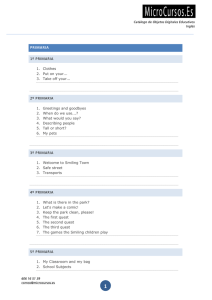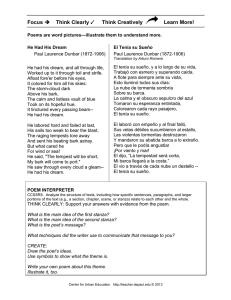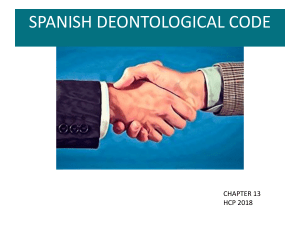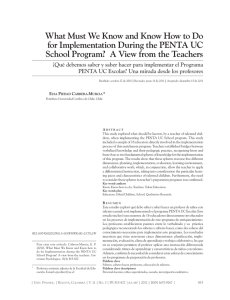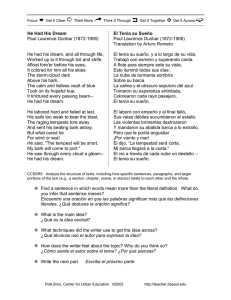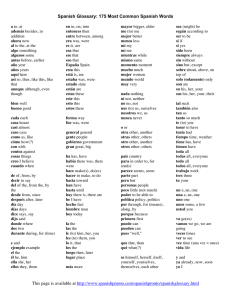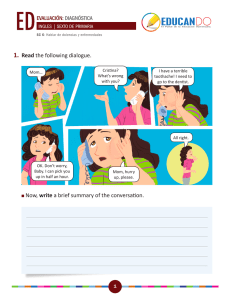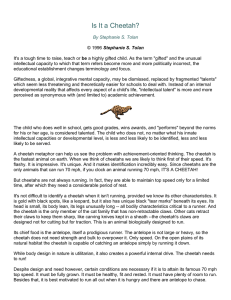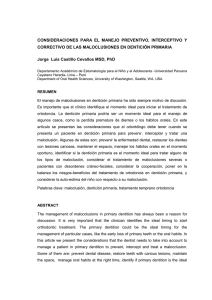Gifted child in the family: Early detection of giftedness
Anuncio
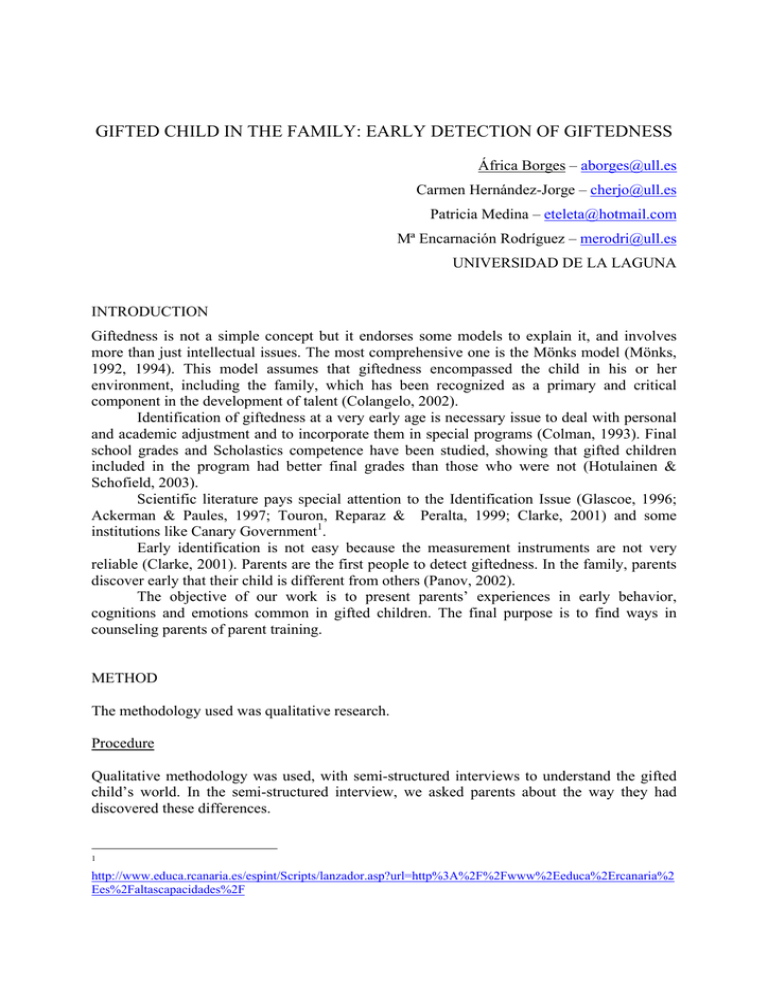
GIFTED CHILD IN THE FAMILY: EARLY DETECTION OF GIFTEDNESS África Borges – [email protected] Carmen Hernández-Jorge – [email protected] Patricia Medina – [email protected] Mª Encarnación Rodríguez – [email protected] UNIVERSIDAD DE LA LAGUNA INTRODUCTION Giftedness is not a simple concept but it endorses some models to explain it, and involves more than just intellectual issues. The most comprehensive one is the Mönks model (Mönks, 1992, 1994). This model assumes that giftedness encompassed the child in his or her environment, including the family, which has been recognized as a primary and critical component in the development of talent (Colangelo, 2002). Identification of giftedness at a very early age is necessary issue to deal with personal and academic adjustment and to incorporate them in special programs (Colman, 1993). Final school grades and Scholastics competence have been studied, showing that gifted children included in the program had better final grades than those who were not (Hotulainen & Schofield, 2003). Scientific literature pays special attention to the Identification Issue (Glascoe, 1996; Ackerman & Paules, 1997; Touron, Reparaz & Peralta, 1999; Clarke, 2001) and some institutions like Canary Government1. Early identification is not easy because the measurement instruments are not very reliable (Clarke, 2001). Parents are the first people to detect giftedness. In the family, parents discover early that their child is different from others (Panov, 2002). The objective of our work is to present parents’ experiences in early behavior, cognitions and emotions common in gifted children. The final purpose is to find ways in counseling parents of parent training. METHOD The methodology used was qualitative research. Procedure Qualitative methodology was used, with semi-structured interviews to understand the gifted child’s world. In the semi-structured interview, we asked parents about the way they had discovered these differences. 1 http://www.educa.rcanaria.es/espint/Scripts/lanzador.asp?url=http%3A%2F%2Fwww%2Eeduca%2Ercanaria%2 Ees%2Faltascapacidades%2F Subjects Ten parents were chosen which consisted of one father, seven mothers and two couples, of gifted children between 10 to 14 years old. Children characteristics are shown in table 1 (age, gender, school level and year, and Intelligence Quotient). Subject Age Table 1. Children characteristics Gender School level Year IQ 1 11 M Primary education 6º Primaria 130 2 13 M Secondary education 3º ESO 146 3 11 M Primary education 6º Primaria 142 4 10 F Primary education 6º Primaria 155 5 13 M Secondary education 3º ESO 157 6 13 F Secondary education 3º ESO 137 7 11 M Primary education 6º Primaria 170 8 15 M Secondary education 4º ESO 143 9 11 M Primary education 6º Primaria 136 10 13 M Secondary education 1º ESO 158 RESULTS We want to know who and when was the first identification of giftedness. Except for one case, it was the family who identified giftedness at an early age (table 2). Table 2. Identification Subjects Identification age Identification Confirmation/Corroboration 1 6 Family Psychologist 2 2 Family Psychiatrist 3 3 Teacher and Psychologist 4 6 Family Family 5 3 Family Administration and Psychologist 6 5 Family Psychologist 7 2 Family Teacher and Psychologist 8 4 Family Teacher and Psychologist 9 8 Psychologist Psychologist 10 9 Family Psychologist Psychologist We differentiate between indicators of early detection: behavior indicators, cognitive indicators and emotional indicators. The most important indicators are the cognitive ones (n=19), table 3. Parents identified cognitive indicators easier than behavioral or emotional indicators. They refer to learning different languages easily (n=1), learning to read early (n=5); having spatial ability (n=2); learning positive attitude (n=4); learning and using their own language (n=2); associating ideas (n=2); memory (n=1) and using mathematics (n=2). Table 3. Cognitive indicators Subjects 1 2 3 4 5 6 7 8 9 10 Total Languages learning Reading learning early Spatial ability Association ideas Positive attitude of learning X X Language learning and use Memory Maths X X X 1 2 X X X X X X X X X X X X X 1 5 2 2 X 4 2 Parents identified in their children behavior that is related to giftedness in the specialized literature (hyperactivity, behavior related with school, etc) (table 4) Table 4. Behavioral indicators Subjects Literal responses Translation 2 “Vomitaba al ir al colegio porque le aburría” He threw up when he got to school because it was boring. 3 “Manipula a las hermanas más pequeñas” He manipulated his younger sisters 4 “Era hiperactiva, no dormía para no She was hyperactive. She didn't sleep desaprovechar el tiempo” because she didn't want to waste time 6 “Se aburría en el colegio” She was bored at school 7 “Al gatear ya intentaba correr” When he crawled, he wanted to run 9 “Era hiperactivo” He was hyperactive He was a normal child 10 “Es un niño normal” He was the first to finish his task at “Era el primero en terminar las tareas school escolares” Finally, parents were concerned with emotional factors, such as their relationship (difficulties in social skills) and fears (Table 5). Table 5. Emotional indicators Subjects Literal responses Translation 1 “Tenía miedo a la muerte” He was afraid of death 2 “Se siente a gusto con los adultos” He was comfortable among adults 3 “Tenía dificultades en sus relaciones He had difficulties in social sociales” relationships She had difficulties in social 6 “Tenía dificultades en sus relaciones relationships sociales” She was afraid of dying “Tenía miedo a morir” 8 “Tenía dificultades en sus relaciones He had difficulties in social sociales” relationships 9 “Tenía miedo a subir al avión, por si le He was afraid of flying pasara algo” DISCUSSION In our study, parents were the first to identify giftedness in their children which occurred in nine cases out of ten. In five families, they observed gifted behaviour before the children initiated primary school (Panov, 2002). The most frequent indicators are cognitive because they are easier to detect by parents. Among the behaviour indicators, we found two cases where hyperactivity was diagnosed instead of giftedness. Sometimes, active behaviour is confused with hyperactivity (Genovard, 1988; Chan & Chan, 1999). Heterogeneity is one characteristic of giftedness (Passow, 1993). In this study we found different cognitive, behavioural and emotional indicators in each family. Identifying giftedness is a very important issue so parents can be conscious of their children’s high abilities and influence in the development of the child’s talent (Feldman & Goldsmith, 1986). Programs to deal with giftedness must include parent counseling, so “Parent’s concepts about giftedness may affect their interpretation of their gifted children’s characteristics and behaviours and influence their reaction to them” (Solow, 2001, pp. 14) REFERENCES Ackerman, Ch.M. & Paules, L.E. (1997). Identifying gifted adolescents using personality characteristics: Dabrowski’s overexcitabilities.Roeper Review, 19 (4) 229-236. Chan, D. y Chan, L.K. (1999): Implicit Theories of Creativity: Teachers´perception of student characteristics in Hong Kong. Creativity Research Journal, 12 (3), 185-196. Clarke, A. (2001). Early identification of gifted students and catering for them in the early stages of kindergarten. Primary Educator, 7 (1) 21-28. Colangelo, N. (2002). Counseling gifted and talented students. The national research center on the gifted and talented. En http://www.gifted.uconn.edu/nrcgt/newsletter/fall02/fall022.html Colman, A. (1993). Identifying the gifted. Youth studies, vol. 12 (4) 11-12. Feldman, D. H., & Goldsmith, L. T. (1986). Nature's gambit. New York: Basic Books. Genovard, C. (1988) Educación especial del superdotado. En A. Mayor (dir) Manual de educación especial. Madrid: Anaya Glascoe, F.P. (1996). Can the BRIGANCE screens detect children who are gifted and academically talented? Roeper Review, 19 (1) 20-24. Hotulainen, R.H. & Schofield, N.J. (2003). Identified Pre-school Potencial Giftedness and its relation to Academic Achievement and Self-concept at the End of Finnish Comprehensive School. High Ability Studies, 4 (1), 55-70. Mönks, F.J., Katzko, M.W. & Van Boxtel, H.W. (1992). Education of the Gifted in Europe: Theoretical and Research Issues. Amsterdam/Lisse: Swest & Zeitlinger. Monks, F.J. (1994) Desarrollo socio-emocional de los niños superdotados. En Y. Benito (dir) Intervención e investigación socioeducativa en alumnos superdotados, págs. 139-152. Salamanca: Amarú Ediciones. Panov, V.I. (2002). Gifted children: Identification, teaching and development. Russian Education and Society,. 44 (10) 52-80. Passow, A.H. (1993). National/state policies regarding education of the gifted. In K.A. Heller, F.J. Monks & A.H. Passow (Eds.), International handbook of research and development of giftedness and talent. Oxford: Pergamon Press Ltd.. Solow, R. (2001). Parent’s conceptions of giftedness. Gifted child today magazine, 24 (2) 1422. Touron, J., Reparaz, Ch. & Peralta, F. (1999). The identification of High Ability Students: results of a detection process in Navarra. High Ability Studies, 10 (2) 163-181.
